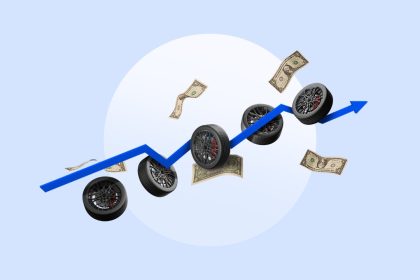Key takeaways
- FAFSA completion rates are consistently lower than college attendance rates among high school graduates.
- Filling out the FAFSA grants access federal financial aid and loans to help fund your higher education.
- There are still advantages to completing the FAFSA even if you don’t qualify for federal aid.
Though Free Application for Student Aid, better known as FAFSA, grants access to a trove of college funding, only 51 percent of high school seniors across the country have completed it this year, according to the National College Attainment Network (NCAN)’s recently updated FAFSA tracker.
Completing the FAFSA should be the first step for students seeking ways to pay for college, but a significant percentage of high school seniors who plan on attending college never complete it. Completion rates in the 50s have been the norm since 2018, except for a dip to 49.9 percent in 2024. By comparison, according to data from the Bureau of Labor and Statistics, between 61 and 69 percent of recent high school graduates have enrolled in college since 1993. Those students who aren’t completing the FAFSA could unknowingly be leaving money on the table.
Why are FAFSA completion rates low?
There isn’t just one reason FAFSA completion rates are lower than the percentage of students attending college. A mix of misconceptions, skepticism, lack of awareness and a botched 2024 season may be keeping students from applying for federal aid. But 2024’s issues have since been addressed and completing the FAFSA form is still the only way to qualify for thousands of dollars in financial aid and loans from the government.
Chaotic 2024 FAFSA Season
Returning FAFSA filers may be apprehensive after last year’s botched rollout of the new form and website. It was likely one of the biggest drivers behind lower completion rates in 2024, according to Jill Desjean, director of policy analysis for the National Association of Financial Aid Administrators.
“The many, many delays. The struggles that students had with just navigating the site. It was very buggy,” she says. “Many people just weren’t able to submit. And so there were big groups of people who were simply shut out from filling out the FAFSA for a long part of the cycle last year.”
Adding salt to the wound, an understaffed Education Department call center left 4 million calls for assistance unanswered, according to the Government Accountability Office.
What about the 2025 FAFSA?
Many of 2024’s issues were caused by major changes to the application and Federal Student Aid website made due to the FAFSA Simplification Act. With those problems smoothed out, what’s left is a simplified application — with significantly fewer questions, a more user-friendly interface, more language options and previously-collected data filled in automatically.
“When it works, it is better,” says Desjean. And it seems that applicants are giving the process a second chance. According to the tracker, as of May 30, FAFSA completion for the class of 2025 was about 20 percent higher than it was for the class of 2024 around the same time last year. In April, the completion rate was up to 62 percent higher.
Lack of awareness and resources
While 2024 was chaotic, Desjean notes one positive result that may have come from the debacle.
“FAFSA was in the news a lot last year,” she says. “It wasn’t good news, but maybe people who didn’t know about financial aid being available were learning about it for the first time. It may have introduced the concept of the FAFSA and the idea that federal student aid is available for college.”
First-generation students whose parents didn’t consider college and, therefore, didn’t seek out ways to pay for it may be among those who are unaware of federal student aid. And while many colleges have dedicated financial aid offices, most high schools lack the resources to reach every student — especially low-income schools.
“If you go to a high school where the guidance office staff is really overworked, and has a huge caseload, they can’t be sitting down one-on-one with students and making sure [they] know [about financial aid],” says Desjean.
This lack of resources is apparent when looking at the FAFSA tracker, which shows a six-percentage-point difference between completion rates at higher-income high schools (54.1 percent) and lower-income schools (48.1 percent), where more students may qualify for aid.
Learn more about the FAFSA
It’s important to know that FAFSA is free to complete and has deadlines. It opens every year on October 1 and the deadline is June 30 of the academic year for which you’re applying for aid. For the 2024-25 school year, the FAFSA deadline is June 30, 2025. The earlier you apply for aid, the better. According to Desjean, while Pell Grants and student loans are always available, state and institutional aid is typically given out on a first come, first served basis.
Besides, as Desjean says, “No one ever said, you filed your FAFSA too early.”
To learn more about the FAFSA, reach out to your high school counselor or college’s financial aid office. You can also learn more about it by visiting StudentAid.gov.
Not required in most states
Thirteen states require FAFSA completion for graduation — and it may make a difference. Of the top 10 states with the most FAFSA completions, six make it a requirement. Of the top five states, four require FAFSA completion. And more than half of the states requiring FAFSA have completion rates above the U.S. average.
According to Desjean, mandating FAFSA completion may help people become more aware of it, but states have to do more than that.
“They can’t just slap on a FAFSA completion requirement and say, ‘Okay, our work is done here,’” she says. “It has to be paired with an outreach. Effort has to be paired with a lot of support for students, so that it isn’t a barrier to graduation.”
If you live in a state that requires FAFSA completion, there may be more support for students. Reach out to local high schools, career planning centers, community colleges and state departments to see if there are FAFSA events happening near you.
What if you don’t need the FAFSA?
If you live in a state that requires FAFSA and you don’t plan on pursuing a college education, you may be able to “opt out” by completing an alternative application or waiver. Speak to your high school guidance counselor or state agency for more information.
Why is it important to complete the FAFSA?
The FAFSA is your ticket to free financial aid and loans with interest rates that are typically better than private loan rates. And since there isn’t a minimum credit score requirement for direct loans, it may be easier to qualify — especially if you, like many high school seniors, have little-to-no credit history.
Without completing the FAFSA, you will not:
Qualify for free money
“I wish [more] people knew that financial aid isn’t just loans,” says Desjean. “[It’s] money to help you go to college.” And that includes money you don’t have to pay back, including federal grants and work study. But you must fill out the FAFSA to qualify for this free aid.
When Jack O’Connor, a business operations analyst at Bankrate, filled out the FAFSA in 2023, he wasn’t sure he would qualify.
“I still thought it was worth it. And my parents still thought it was worth filling out, because, I guess, you never know.”
And while he didn’t qualify for free aid, he still encourages students to try. “I feel like it wouldn’t make sense to just not fill it out, because that’s just leaving money on the table if you do end up qualifying for it.”
He’s not wrong.
According to NCAN, the class of 2024 failed to claim close to $4.4 billion in unclaimed Pell Grants.
It isn’t just the federal government that uses the FAFSA to determine financial awards. Many states and colleges also use it to decide whether to award students grants, scholarships or institutional loans.
Qualify for federal student loans
While federal student loans are money you have to pay back, they often come with lower interest rates and benefits like income-driven repayment plans, forbearance and potential student loan forgiveness.
Federal loans were the biggest draw for Bankrate Engineering Manager Jason Braucht, who helped his two college-aged children and PhD-pursuing wife complete their FAFSAs.
“The only thing I was looking for was a relatively low interest rate on loans,” he says. “Even though [they’re] unsubsidized loans, they’re usually a better alternative to private student loans.”
Braucht liked the fact that the loans are in the kids’ names, pointing out that if they were going to try to get a loan on their own elsewhere, he would’ve had to cosign at the very least. And even if they were able to qualify for a student loan without a cosigner, they’d likely get a high interest rate.
Federal loans have the same fixed interest rate — 6.39 percent for direct subsidized and 7.94 percent for unsubsidized in 2024-25 — no matter a borrower’s credit. “That matters when you’re paying something off over 10 years,” he says.
Calculate your total interest paid
A student loan calculator can show you how much interest you’ll pay over the life of your loan. Input various interest rates to see what a difference it can make.
Bottom line
Though completion rates are up compared to 2024, ideally, all college-bound students should complete the FAFSA. If you haven’t yet, you still have time.
“Even if you don’t think you’re gonna get federal money, your school could end up giving you money,” says O’Connor, whose school offered more need-based aid than merit-based. “And I feel like it’s not a particularly difficult form to fill out, considering what the benefits could be.”
Why we ask for feedback
Your feedback helps us improve our content and services. It takes less than a minute to
complete.
Your responses are anonymous and will only be used for improving our website.
Help us improve our content
Read the full article here
















